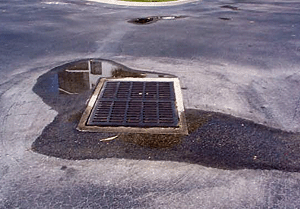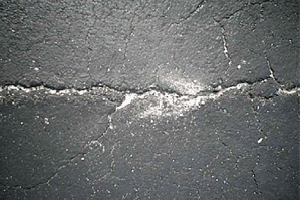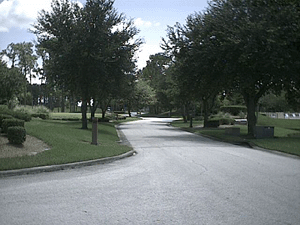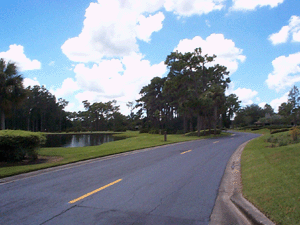One of the biggest areas overlooked during budgeting is asphalt maintenance. We look at it every day and yet, when time comes for sealcoating or overlays, we never seem to have budgeted enough, or worse, we don't even begin to know what to do about the problems anyway.
In an effort to assist property managers and board members, I offer the following terminology in order to familiarize them with asphalt maintenance:
 Asphalt - This
is usually the material that your parking lots are made of. It consists of
tars, oils, sands, bituminous matter and rock. The original asphalt cap could
be as thick as three inches or as thin as one inch.
Asphalt - This
is usually the material that your parking lots are made of. It consists of
tars, oils, sands, bituminous matter and rock. The original asphalt cap could
be as thick as three inches or as thin as one inch.
- Ponding - This is an area where water puddles due to the lack of
drainage or the inability to drain properly.
- Unraveling - When the tars, sands, oils and finites begin to dissolve and disappear, your asphalt is left exposed and crumbly.
- Potholes - These are the areas of your asphalt that have deteriorated to the point that the asphalt has been removed or washed away and your subbase is exposed. This, if not taken care of immediately, will continue to grow in size and can do more damage if neglected over a period of time. Potholes occur for reasons such as standing water, high traffic, sealcoat breakdown, gouges and even sinkholes or washouts.
 Cracking -
Cracks occur due to numerous reasons from the settling of your asphalt,
reaction to sealcoating or just plain old age. Crackfilling is used to seal
cracks in your asphalt that are about a fourth of an inch in width. The cracks
are routed to a uniform depth and then a hot rubberized material is injected
into the crack and leveled. This is usually done prior to an overlay or after
your property has been sealcoated or sealed.
Cracking -
Cracks occur due to numerous reasons from the settling of your asphalt,
reaction to sealcoating or just plain old age. Crackfilling is used to seal
cracks in your asphalt that are about a fourth of an inch in width. The cracks
are routed to a uniform depth and then a hot rubberized material is injected
into the crack and leveled. This is usually done prior to an overlay or after
your property has been sealcoated or sealed.
- Sealcoating - Sealcoating is a water-based coal/tar emulsion that is applied to your asphalt to protect it as well as give it an aesthetically appealing look. Asphalt sealcoating is sprayed on or squeegeed on, depending on the contractor. Either method is acceptable.
Sealcoating should be applied every one to three years and at times can last longer. Because asphalt sealcoating is water-based, it will eventually fade or peel away as it ages, leaving your property streaky and patchy looking. Signs of sealcoating will be darkened edges and faded travel paths more evident at entrances and turn areas. This is visually unattractive and will only get worse until the next coating is applied.
Another thing to consider is that your asphalt and sealcoating expand and contract at different levels causing the sealcoating to crack and begin pulling apart at the asphalt underneath. As it ages and through weathering, these cracks will begin to grow and join together and will have to be addressed as they will eventually become potholes. They can also cause a complete breakdown of your asphalt cap if not properly maintained. In addition, another downfall of sealcoating is that because it sits on top of your asphalt, it usually takes away the natural resistance of the peaks and valleys caused by the rock and tars. As a result, your property actually becomes more slippery and conditions are better for hydroplaning.
-
 Rejuvenation
- Over time, the tars and oils that surround the rocks that make up your
asphalt eventually begin to dry up and evaporate. When this occurs, the rock
that makes up the binder becomes exposed causing early stages of
deterioration. If left untreated, the rock will eventually become loose and a
complete overlay will be needed.
Rejuvenation
- Over time, the tars and oils that surround the rocks that make up your
asphalt eventually begin to dry up and evaporate. When this occurs, the rock
that makes up the binder becomes exposed causing early stages of
deterioration. If left untreated, the rock will eventually become loose and a
complete overlay will be needed.
Pavement Dressing Conditioner (PDC) Asphalt Rejuvenator treatment is an oil-based product that is applied to untreated asphalt in order to reinstate the tars and oils that are lost due to weather and oxidation and will immediately stop the aging process. PDC penetrates and it will expand and contract with your asphalt thus avoiding the cracking that occurs with water-based sealers. Because it is absorbed, it does not alter the surface, making the asphalt more skid resistant when compared to water-based sealcoating. PDC rejuvenator is fuel-resistant and water-resistant as well. It is recommended to apply PDC every three to five years but it has been known to last up to seven years. Most rejuvenators cannot be applied over previously water based sealcoated properties, as the oil-based product cannot penetrate water-based sealcoats. Most rejuvenators are typically applied to asphalt areas that have never been treated of within eight months of curing for new overlays.
 Overlay - There are a couple of different types of overlay. The
most inexpensive is applying a one-inch overlay asphalt cap that is put on top
of your existing pavement. Most major areas of deterioration will be repaired
prior to this type of overlay. This procedure will give your asphalt a brand
new look and can be maintained for years to come with properly scheduled
maintenance. If you are overlaying on top of previously sealcoated area that
has cracks, these cracks will in time rise to the top of your new
overlay. Some properties take precautionary measures by having the larger
cracks filled prior to the overlay and this procedure is highly
recommended.
Overlay - There are a couple of different types of overlay. The
most inexpensive is applying a one-inch overlay asphalt cap that is put on top
of your existing pavement. Most major areas of deterioration will be repaired
prior to this type of overlay. This procedure will give your asphalt a brand
new look and can be maintained for years to come with properly scheduled
maintenance. If you are overlaying on top of previously sealcoated area that
has cracks, these cracks will in time rise to the top of your new
overlay. Some properties take precautionary measures by having the larger
cracks filled prior to the overlay and this procedure is highly
recommended.
Another type of overlay is when the contractor will mill out and remove the old asphalt down to the subbase. He will then level and compact this area (subbase) and apply two to three inches of asphalt and roll and compact it to the proper density. This is very beneficial if your property was previously sealed and was experiencing great levels of deterioration in the form of potholes, cracks, and unraveling. This new look will allow you to start over and have the opportunity to start over and to make more educated decisions about maintenance in the coming years.
In order to protect yourself and your decisions, I recommend to all boards and property managers that you make sure the business you are using is registered through the state of Florida. You can check this out by going to www.Sunbiz.org, which is the website for the state of Florida, Division of Corporations. In addition, always remember to get three estimates, ask for references, confirm they have general liability insurance as well as workmen�s compensation and confirm who will be performing the work. There is a limited amount of licensed applicators for the rejuvenation process. Some of the products available do not have the testing or data information regarding their product. If they don't have it, beware!
Your asphalt doesn't have to be a funnel for maintenance dollars. With the right maintenance and treatment, your pavement can be an investment rather than an expense.
Article written by Connie Lorenz who is currently President of Asphalt Restoration Technology of Florida.
